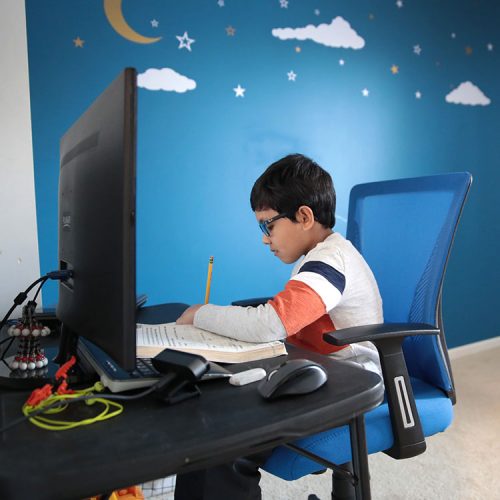Since the pandemic, digital learning has become a permanent fixture in U.S. education. While most schools have returned to in-person instruction, millions of students still rely on hybrid or online courses. In 2022, about 26% of students (4.9 million) were enrolled exclusively in distance learning, and hundreds of schools remain fully virtual. Even in traditional classrooms, digital devices are now central to daily instruction, meaning children spend more time than ever in front of screens.
What is Digital Eye Strain?
Digital eye strain (DES), also called computer vision syndrome, refers to eye discomfort and vision problems caused by prolonged screen use. Symptoms in children include:
- Headaches
- Neck/shoulder pain
- Eye strain and blurred vision
- Dry or irritated eyes
- Irritability and reduced attention span
Recent studies show that children aged 8–12 average 4.4 hours of daily screen use, while teens average over 7 hours. Excessive screen time has also been linked to increased risk of myopia (nearsightedness) in children.
How to Protect Your Child’s Eyes
Parents can take proactive steps to reduce DES:
- Follow the 20-20-20 rule: Every 20 minutes, look at something 20 feet away for 20 seconds.
- Encourage blinking: Screen use reduces blink rate, leading to dryness.
- Check ergonomics: Position screens 16–30 inches from the eyes, with the top slightly below eye level.
- Adjust brightness and text size for comfort.
- Blue light glasses? Evidence is mixed. While marketed to reduce eye strain, experts note that blue light from screens is far weaker than sunlight exposure, and benefits are limited. Still, some families find them helpful for reducing glare.
- Prioritize outdoor time: Studies show outdoor play reduces risk of myopia progression.
- Schedule routine eye exams: Early detection ensures vision problems don’t interfere with learning.
Why This Matters
The American Academy of Pediatrics emphasizes that screen time should be balanced with offline activities. While no strict “safe limit” exists, experts recommend interactive, age-appropriate use and family-wide boundaries.
Sources
